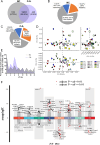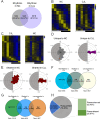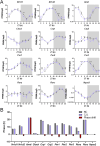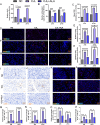Chronic Jet Lag Disrupts Circadian Rhythms and Induces Hyperproliferation in Murine Lacrimal Glands via ROS Accumulation
- PMID: 39775698
- PMCID: PMC11717126
- DOI: 10.1167/iovs.66.1.12
Chronic Jet Lag Disrupts Circadian Rhythms and Induces Hyperproliferation in Murine Lacrimal Glands via ROS Accumulation
Abstract
Purpose: Chronic jet lag (CJL) is known to disrupt circadian rhythms, which regulate various physiological processes, including ocular surface homeostasis. However, the specific effects of CJL on lacrimal gland function and the underlying cellular mechanisms remain poorly understood.
Methods: A CJL model was established using C57BL/6J mice. Extraorbital lacrimal glands (ELGs) were collected at 3-hour intervals for RNA extraction and high-throughput RNA sequencing. Circadian transcriptomic profiles were analyzed, and functional annotations were performed. Hydrogen peroxide levels and total antioxidant capacity in tear fluid were measured using chemometric assays. Immunofluorescence was used to assess cell proliferation, apoptosis, immune cell infiltration in ELGs, and reactive oxygen species (ROS) accumulation. The potential therapeutic effects of alpha-lipoic acid (ALA) on CJL-induced oxidative stress and pathological changes in ELGs were also investigated.
Results: CJL significantly disrupted locomotor activity, altered body temperature rhythms, and modified diurnal oscillations in ELGs. Transcriptomic analysis revealed extensive changes in rhythmic gene expression, phase shifts, and pathway clustering in response to CJL. The disruption of the core circadian clock transcription was associated with ELG hyperproliferation and increased ROS accumulation. tert-Butyl hydroperoxide promoted ELG cell proliferation, and ALA effectively reduced ROS levels and mitigated CJL-induced hyperproliferation.
Conclusions: These findings uncover novel molecular pathways affected by CJL and highlight the potential of antioxidant therapies, such as ALA, in preserving ocular surface health under conditions of circadian rhythm disruption.
Conflict of interest statement
Disclosure:
Figures













Similar articles
-
Circadian disruption and ROS-NLRP3 signaling mediate sleep deprivation-enhanced silica nanoparticle toxicity in lacrimal glands.J Nanobiotechnology. 2025 Sep 2;23(1):600. doi: 10.1186/s12951-025-03630-5. J Nanobiotechnology. 2025. PMID: 40890823 Free PMC article.
-
Light cycle phase advance as a model for jet lag reprograms the circadian rhythms of murine extraorbital lacrimal glands.Ocul Surf. 2021 Apr;20:95-114. doi: 10.1016/j.jtos.2021.02.001. Epub 2021 Feb 11. Ocul Surf. 2021. PMID: 33582293
-
Sleep Loss Causes Dysfunction in Murine Extraorbital Lacrimal Glands.Invest Ophthalmol Vis Sci. 2022 Jun 1;63(6):19. doi: 10.1167/iovs.63.6.19. Invest Ophthalmol Vis Sci. 2022. PMID: 35731510 Free PMC article.
-
From circadian clock mechanism to sleep disorders and jet lag: Insights from a computational approach.Biochem Pharmacol. 2021 Sep;191:114482. doi: 10.1016/j.bcp.2021.114482. Epub 2021 Feb 20. Biochem Pharmacol. 2021. PMID: 33617843 Review.
-
A new mouse model of dry eye disease: oxidative stress affects functional decline in the lacrimal gland.Cornea. 2012 Nov;31 Suppl 1:S63-7. doi: 10.1097/ICO.0b013e31826a5de1. Cornea. 2012. PMID: 23038038 Review.
Cited by
-
Plin2 Coordinates Immune and Metabolic Reprogramming in Lacrimal Gland Aging.Invest Ophthalmol Vis Sci. 2025 Jun 2;66(6):79. doi: 10.1167/iovs.66.6.79. Invest Ophthalmol Vis Sci. 2025. PMID: 40569117 Free PMC article.
-
Circadian disruption and ROS-NLRP3 signaling mediate sleep deprivation-enhanced silica nanoparticle toxicity in lacrimal glands.J Nanobiotechnology. 2025 Sep 2;23(1):600. doi: 10.1186/s12951-025-03630-5. J Nanobiotechnology. 2025. PMID: 40890823 Free PMC article.
-
Circadian clocks and their role in kidney and eye diseases across organ systems.Front Physiol. 2025 May 27;16:1583502. doi: 10.3389/fphys.2025.1583502. eCollection 2025. Front Physiol. 2025. PMID: 40496242 Free PMC article. Review.
References
-
- Patke A, Young MW, Axelrod S.. Molecular mechanisms and physiological importance of circadian rhythms. Nat Rev Mol Cell Biol . 2020; 21(2): 67–84. - PubMed
-
- Sack RL. Clinical practice. Jet lag. N Engl J Med . 2010; 362(5): 440–447. - PubMed
-
- Waterhouse J, Reilly T, Atkinson G, Edwards B.. Jet lag: trends and coping strategies. Lancet . 2007; 369(9567): 1117–1129. - PubMed
-
- Filipski E, Delaunay F, King VM, et al. .. Effects of chronic jet lag on tumor progression in mice. Cancer Res . 2004; 64(21): 7879–7885. - PubMed
MeSH terms
Substances
LinkOut - more resources
Full Text Sources

